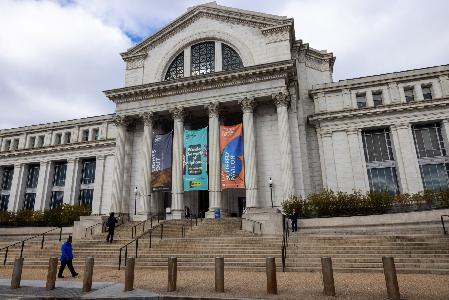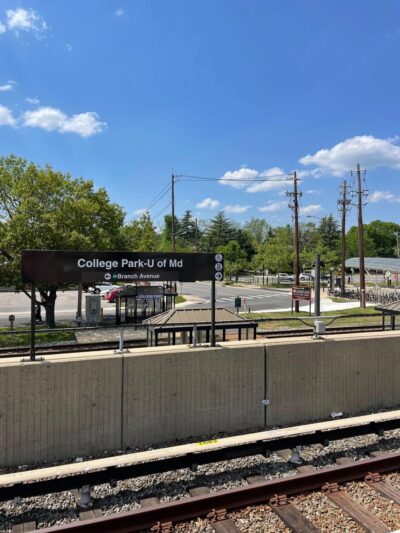For most businesses, 2020 was a time to pivot, to adapt, to grow stronger with resilience — or to flounder among amid rapidly changing economic forces.
CEO and founder Brent Lightner says Taoti Creative is solidly in the former camp.
With nearly 25 years in business, Taoti has consistently found ways to adapt its services. The company was founded in 1996 as a web development shop, but it has since evolved into a full-service creative agency specializing in web and digital projects, AR/VR, experiential marketing, social media management and the like. After more than five relocations, Taoti moved into its Barracks Row office in January 2020.
One example of pandemic-time innovation: It developed a virtual event platform to offer a more unified experience for people attending online programs, with an integration feature if users want to add their own videoconferencing and streaming services from Zoom, GoToWebinar, Vimeo or others. As of September, the platform has already been used to host large-scale events like the Brussels Forum, an international event that took place in June and featured more than 80 speakers across 26 virtual sessions.
Over the course of 2020, Taoti worked on projects with Union Plus and the DC Lottery. It also hired 16 new full-timers in the DMV, and Lightner said it has grown revenue 24% from 2019. (The agency did take advantage of some federal relief funding, though its benefit was limited, as about a third of its staffers are contractors instead of W2 employees, the CEO said.)
Lightner attributes the year’s success to an innovative team and more efficient working conditions — namely, all-virtual everything. He answered some Qs via email about Taoti’s new events platform, remote work culture and how the company is thinking about returning to the office. His responses have been edited for length.

Brent Lightner. (Courtesy photo)
Technical.ly: The events industry was completely upended in 2020. How did Taoti pivot to meet the switch to virtual?
Brent Lightner: Taoti wasn’t really in the event space prior to the pandemic, so I wouldn’t call it a “pivot.” Our delve into the virtual event space was invention by necessity.
The majority of our clients (nonprofits and associations) were big into events, but our involvement was usually limited to updating their websites or microsites around those events. When everyone went virtual, we just assumed that there would be a big player out there with a good, all-encompassing virtual event offering. We looked high and low to help our clients find something. Zoom and the like were fine for conferencing, but there was no branding — no real conference “feel” to it. Some microsites allowed for all the content and supporting event functionality, but they didn’t have the key component: video streaming. Sure, you could get each separately — build a microsite and then email around a bunch of Zoom links — but that was a clunky solution at best. We finally decided no one really had a good offering here, so we invented our own virtual event platform that is effectively the best of both worlds.
It’s fundamentally a microsite that can be totally branded and developed to look like or do just about anything one would want. But it has the video conference built into it, center stage. We typically embed Zoom because it’s what most of our clients know and love, but really, we could embed any of the video conference options out there. The result is a highly integrated video conference platform embedded in a branded, highly polished virtual experience. It doesn’t try to replicate a physical event space like some of the avatar-based systems do. Instead, our platform leans into the fact that it’s virtual and that we can do things that can’t be done in the “real world.”
How did Taoti handle going virtual early last year?
To understand how we went virtual as a firm, you need to understand a bit about my own historical pressure points. I recall from the “old days” — I learned the internet on Netscape, if that’s any indication — infuriating instances where in-office servers would go down, employee computers would die. Or before everything was in the cloud, there would be data in one place that wasn’t in another place when you needed it to be. So as the cloud came about, I was an early adopter just to alleviate the pain of being so dependent on the physicality of operations.
This is all to say that we’ve been well equipped to “go virtual” for years. In fact, we effectively were already virtual as far as infrastructure went. Because almost a third of our team is full-time remote anyway, we already had operational procedures in place for collaborative work, meetings, etc. The big shift was more in getting the non-remote portion of our team to fully embrace the “remote culture” the way that part of our team already did. We actually learned a ton from them and are now a better company because of it.
It’s the little things like turning on screens, letting people know what you’re working on, sending a quick note in Slack when you need to go offline for a bit, establishing good work-from-home routines and boundaries, etc. To this day, we do still miss our full-wall whiteboards. The electronic version of them is great (even better in some regards), but nothing smells like creativity at work better than a bunch of dry erase markers in the room!

The Taoti team on May 4, 2020. (Courtesy image)
How is the Taoti team more effective now, in 2021?
We’re more efficient now that we don’t have to travel to meetings and prepare physical spaces, lunches, etc. Whereas before we’d be more prudent about taking people to a meeting (since that might blow half a day of effort), it’s now easier to include more of the team since an hour meeting just takes an hour and not most of the morning with transit and setup, etc. Overhead is down, and productivity is up.
Personally, I’ve discovered a whole new level of inclusivity awareness that I hadn’t even considered before. When we were in the office, most of my casual interactions with staff (which can be critical feedback loops to know how the team is doing and what is or isn’t working) were limited to those in my physical proximity — the “water cooler” group, if you will. Now that no one is local, I’ve taken to reaching out randomly on Slack to team members up and down the org chart just to do five-minute check-ins to see how people are doing and what ideas they have for me. And in doing so, I’m reaching out to everyone, not just the in-house team.
This is definitely something that I will keep doing regardless of if/how we come back, as it’s very informative for me. I also think it is appreciated by the team, as well. I feel much closer to the whole team up and down the chain of command.
What lessons have you learned about virtual workplace culture that will stay beyond the pandemic?
Everyone being remote really levels the playing field for the third of our company that was already fully remote.
One lesson learned is hybrid meetings (in which some are in a room and some are remote) are in some ways the worst of both worlds. At the beginning of the pandemic, where we still had a few people coming into the office, we would gather in a room for meetings, and a couple of us would be on one video feed while several others at home each had their own feed. This wasn’t a great format. We found that even when we were in the office, it worked far better for each of us to log on from our individual computers and treat the meeting as if we were all remote. I wasn’t expecting this, but it makes sense that this works better.
So, the lesson is that if it’s a Zoom meeting, it’s best for everyone to dial in separately instead of having some people share a cam, even if they are able to do so. This dynamic will play a big part in how we come back, I’m sure.
We covered Taoti’s newest office at the top of 2020. Will the team return, or are you all rethinking whether it’s necessary to meet in person?
The short answer is that I don’t know exactly if/how/when we come back. I suspect we will return in some capacity, but I doubt it looks like what it did before. Being remote has proven that we are more than capable of being a truly distributed/remote company. There are actually many ways in which things work better this way.
But a big part of this is because our clients are all remote too, so it works well for the reasons I mentioned above. If/when our clients come back and want to have in-person meetings again, that will shift the dynamics. Even so, several of our employees have already relocated away from the DMV permanently — something I signed off on that I probably wouldn’t have before. I have no doubt that no matter what shape things take, we’ll be revisiting how we think of remote work as a whole.
It’s also worth noting that it would be naïve to assume that every employee thrives under the same conditions and that a one-size-fits-all policy is the right course of action. Some love being fully remote and never having to waste time with a commute. But there are also those who miss the in-person interactions and social activities. It’s easy to suggest that we’d just let employees choose how they prefer to operate and come in when they needed/wanted to, but it’s not that simple.
My hunch is that we end up with some sort of hybrid model in which we do maintain a physical space that is generally occupied daily, but that it becomes a far more flexible situation in which people come in either as needed or by choice, such that we can maintain a much smaller footprint while still offering a physical space for us to leverage with clients and those employees who enjoy a more traditional office situation.
With employee growth during the pandemic, will you need more space if you do return to the office?
We are wrapping up the finishing touches on about 6,000 square feet of new office space to expand our existing office. I’m not at liberty to get into too much detail yet, but because of the way things have transpired over the last year, we find ourselves considering additional new office space in the area. Pre-pandemic, this would have been a no-brainer. Frankly, this new space was always part of the “five-year plan,” as our growth trajectory easily justified what would have been a quadrupling of our overall office footprint. But now, I find myself wondering if we need it? If we don’t come back in full force and instead figured out some sort of hybrid/rotation/as-needed type of system as far as in-house people go, we could grow the company’s size without needing to grow the size of the office.
On the other hand, more space would give us the ability to grow in the events venue arena as we look to service more clients needing hybrid event space (not to mention our own project/fabrication space, or even a community-centric venue for special events, art installations, experiential marketing plays, etc.). So lots of moving parts right now, and I’m not sure where things will land. Stay tuned.
Join the conversation!
Find news, events, jobs and people who share your interests on Technical.ly's open community Slack

DC daily roundup: April's biggest DMV funding stories; VCs head to Hill and Valley Forum; AI lobbying tripled

DC daily roundup: DMV innovation's movers and shakers; DDOT's social media troll; facial recognition tech at DCA and BWI

DC daily roundup: An athletic tech acquisition; a reflection on summer 2020's equity promises; data center taxes


